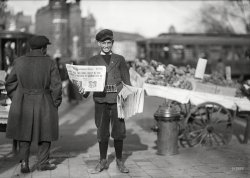
MAY CONTAIN NUTS

Search Shorpy
SHORPY ART

Framed or unframed, desk size to sofa size, printed by us in Arizona and Alabama since 2007. Explore now.
Join and Share
Ad-Free Shorpy
Shorpy is funded by you. Patreon contributors get an ad-free experience.
Learn more.

Recent comments
- Complicated then, forgotten now
- Bryan-Stevenson
- Skinny is as skinny does
- How do you rest in peace
- Riding the footboards
- Alas, hidden from view
- Baldwin Diesels
- Exclusive pump
- Bananas, Oysters and Smokey Joe
- Details, Details
- What's that building to the left of the tower?
- Coal Barges
- Bromo-Seltzer
- Inner harbor
- The Basin
- What a headache!
- Giant stepladder?
- Yeah, it was cold
- Love those coats
- Link & Pin Days Remnant
- Baldwin 62303
- Baldwin VO-1000
- Cold
- No expense spared
- Tough Guys
- What's your hurry, where's your hat?
- Sheriff's Signature
- Relocated in the Eighties
- Lost in Toyland
- And without gloves
Member Photos
The Shorpy
Print Emporium
Print Emporium
Search Shorpy
Search results -- 30 results per page
- Mo and Mammy: 1927
- ... 2756 Woodley pl. nw., and Mrs. Gertrude Sollod of Baltimore, and three grandchildren.
Funeral services will be held at 12:30 ... Posted by Dave - 08/27/2012 - 5:05pm -
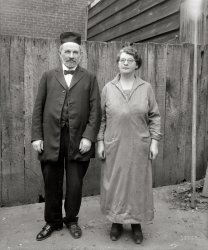
- Prices Cut to the Bone: 1909
- ... bustling retail corridor, home to the Taft Dental Parlors, Baltimore Lunch, Kugler's, Stein's and Mockett's. 8x10 glass negative, Detroit ... Posted by Dave - 08/13/2012 - 7:26pm -
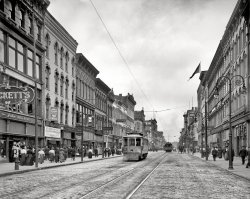
- Swiping Coal: 1917
- ... with three sisters and four brothers lived in an area in Baltimore then known as Goat Hill (long forgotten now) just off the end of 25th ... Posted by Dave - 09/30/2020 - 2:36pm -
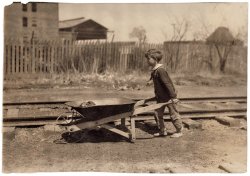
- Housing Boom: 1923
- ... Grow Up In I was raised in a similar rowhouse block in Baltimore.
Those porches brought back some on the joys of my youth and the ... Posted by Dave - 09/11/2011 - 1:18pm -
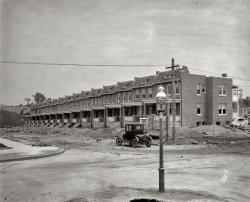
- Hotel Fire: 1963
- ... in other hotels where the cast stayed in Minneapolis and Baltimore."
'56 DeSoto That tailfinned beauty in front of J.J. ... Posted by Dave - 07/23/2015 - 12:09pm -
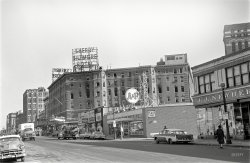
- Raise Your Bottles High
- ... Brakeman, Jimmy Rogers.
The beer is American (a local Baltimore brand) and the RR cap a gift from an uncle who worked as a conductor ... in the rear of the 3300 block of Elmora Ave in Northeast Baltimore, circa 1948. View full size.
American Brewery Ah, American ... Posted by EvenSteven - 12/13/2011 - 11:44am -
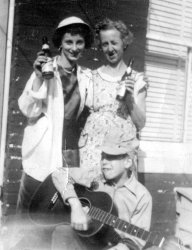
- Cookies: 1896
- ... this series. My great uncle Joe Latham seved on the U.S.S. Baltimore during this time period.
A small point In a racially ... Posted by Dave - 07/29/2012 - 10:14am -
![Cookies: 1896 Circa 1896-1899. "Berth deck cooks aboard cruiser U.S.S. Brooklyn." 8x10 inch glass negative by Edward H. Hart, Detroit Publishing Co. View full size.
I'm wondering about morale on this shipOne half-smile, two faint attempts at a smile and otherwise a whole lot of grumpy goin' on.
Nice shoesA classic and very smart sailor uniform style. Flared trousers, of course! Notice those elegant, but extremely worn out shoes they all have on.
More than cooks here?The two men to the left of the bell are wearing distinctly different uniforms. The cap insignias are a bit too small to discern. Are they Marines?
Also, about 8 of them are wearing lanyards. Are they bosuns?
ThanksThanks for this series. My great uncle Joe Latham seved on the U.S.S. Baltimore during this time period.
A small pointIn a racially segregated navy we have two black men just part of the crew, somewhat startling for 1896?
[Other contemporary examples can be found here, here, here and here. Segregation came to the Navy under President Wilson in 1913. -tterrace]
(The Gallery, Boats & Bridges, DPC, E.H. Hart)](https://www.shorpy.com/files/images/4a14111a.thumbnail.jpg)
- Hudzik & Hornbrook: 1924
- ... Hudzik, CTC (Chief Turret Captain), 306 S. Washington St., Baltimore, MD
1944 duty station: US Naval Fleet Service Schools, N.O.B. ... Posted by Dave - 05/06/2017 - 3:35pm -
![Hudzik & Hornbrook: 1924 August 2, 1924. Washington, D.C. "F.R. Hudzik & H.W. Hornbrook." And that's all they wrote. National Photo Company Collection glass negative. View full size.
Sock styleQuestion to (ex) US naval servicemen: Is that the regulation style to wear one's socks? Rolled down to the top of the boots?
In the West German army that was heavliy frowned upon by the Feldwebels (OR-6 and above).
Anyway, urban pigeons are a nuisance at best and an official pest at worst. Dave, I don't think those "do not feed" critters are providing all that much to feed us in turn. I'm sure I don't even want to try "colombe sautée à la mode urbaine". Not even extra well ;-)
ForbiddenIn the city where I live, Montreal, it is illegal to feed wild urban critters, with a fine of $60. I translate from the City's website: "Pigeons, squirrels, and seagulls quickly become invasive when they're fed. Think of the gatherings of seagulls around picnic tables, the droppings left by pigeons, and the ravages of which squirrels are capable in gardens, not to mention the risk of bites for little children." Signs in parks go into greater detail about the imbalance to animal populations in the city when people feed them.
[I wonder how the critters feel about feeding us. -Dave]
Future USN weapons ChiefsFrank R. Hudzik, CTC (Chief Turret Captain), 306 S. Washington St., Baltimore, MD
1944 duty station: US Naval Fleet Service Schools, N.O.B. Norfolk, VA
Enlistment Date 1: 30 Dec 1918, Release Date 1: 19 Jun 1926
Enlistment Date 2: 18 Sep 1926, Release Date 2: 07 Sep 1939
Enlistment Date 3: 29 Nov 1941, Release Date 3: 26 Jul 1947
Birth: 28 Sep 1901, Death: 23 Dec 1987
[source: Fold3.com]
Harry W. Hornbrook, CFC (Chief Fire Controlman),
1939 duty station: USS Aylwin (DD-355), Muster Roll of the Crew for the quarter ending 31 March 1939, Date reported on board: 04 Aug 1938;
transferred to USS New York on 04 July 1940
Enlistment Date: 25 Sep 1914, Release Date: 31 Jan 1945
Birth: 16 May 1892, Death: 11 Feb 1976
[source: Fold3.com]
Pulling libertyWhen I was in the Navy boondockers were only for work, low cuts were dress shoes. Did many things on liberty but feeding birds was not on the list.
Nice Spit Shine But ...Navy regs said shoes need only be well-blackened. Who was I to dispute the mighty Navy regs writer, so after boot camp I well-blackened a pair of dress shoes and wore them only on inspection days along with either one of two sets (white or blue) dress outfits I kept for inspection only.
Speaking of inspections, I loved it when the inspecting officer was a Lieutenant Commander or above. They breezed through with hardly a glance but those junior grades of officers, especially ones with still the smell of Annapolis on them, would treat inspections as though a pair of not well-blackened shoes would allow the enemy to scuttle the ship.
Feeding birds and squirrels on liberty? Either it was the day before payday or they thought Washington girls might have a soft spot for gobs who fed cute little animals.
Boondockers?Those look more like high-tops like my grandfather used to wear than boondockers. Look at the shine he's got on them. As for the socks, white and rolled down were probably unauthorized.
Reminds me...of the Tom Lehrer tune, "Poisoning Pigeons In the Park."
DC SquirrelsThe squirrels around the reflecting pool are very tame, even today. They will actually come up and beg on their back legs for food.
Interestingly Washington DC has a sizable populations of black squirrels. This is the result of some squirrels from Toronto Ontario that were introduced into the National Zoo back at the turn of the 20th Century.
(The Gallery, D.C., Natl Photo)](https://www.shorpy.com/files/images/SHORPY-11899u.thumbnail.jpg)
- Glen Echo Park: 1928
- ... seemed to be a fortune teller at those Arcades.
In the Baltimore area's Gwyn Oak Park & Carlin's the same lady ruled both houses. ... the Johnstown Flood, The San Fransisco Earthquake, The Baltimore Fire, WWI and old silent cowboy movies.
There were machines ... Posted by Dave - 08/18/2012 - 12:02pm -
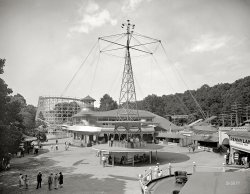
- Last Ones In: 1943
- ... find it jingle Summer Teen radio in the Washington, DC- Baltimore area in the '50s and early '60s was constantly peppered with the Glen ... Posted by Dave - 11/16/2015 - 4:39pm -
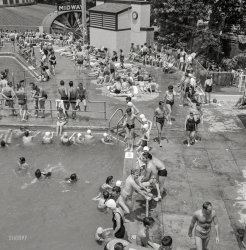
- American Gothic: 1923
- ... I got to see him play after the St Louis Browns moved to Baltimore and the Red Sox came to town. Fortunately my allowance had been ... Posted by Dave - 08/06/2012 - 1:57pm -
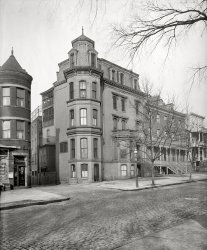
- Rooftops of Washington: 1901
- ... an erroneous notation in the LOC photo caption.) The old Baltimore & Ohio rail station, soon to be demolished with the opening of ... Posted by Dave - 02/06/2021 - 10:03am -
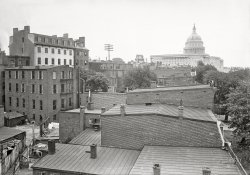
- Rock Around the Clock: 1956
- ... Holly, Fats Domino,Chuck Berry etal) at the Coliseum in Baltimore in the late 50's I can assure you that the cops were heading down the ... Posted by Dave - 08/05/2014 - 9:49am -
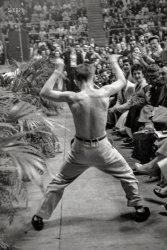
- Carbery Mansion: 1901
- ... throughout Europe. His Highness stated to the Diocese of Baltimore that he would offer up a prayer the tenth of every month at 9 a.m. ... Posted by Dave - 09/12/2011 - 5:02pm -
![Carbery Mansion: 1901 Washington, D.C., circa 1901. "Carberry [Carbery] Mansion." Built for Thomas Carbery in 1818 at 17th and C Streets N.W. National Photo Co. View full size.
Fixer-UpperThis is what used to be called a handyman's special, needs a little work. I'm not a snob, but calling this a mansion is a bit of a stretch.
Double-dare SpookyNothing in a neighborhood could fire a young boy's imagination quite like a huge run down and empty old house. I wish that I, along with my boyhood friends, could jump into this picture today.
On the EdgeThe mansion was razed in 1903; Carbery was Mayor of Washington from 1822 to 1824 and I'm sure the mansion was in better shape back then!
"Miracle House"I suppose I don't have the eye for spookiness which other commenters readily pick up on: before finding the following article I viewed this house as a typical run-down dwelling. Also, it seems to me (a non-Catholic) that Prince Hohenlohe received an inordinate degree of credit for Ms. Mattingly's "cure."
Miracle House
by Marie Lomas
Washington's Miracle House has again come to light. A water color painting discovered a few days ago by the curator at a local museum brings up a story stranger by far than many of the bizarre tales of fiction. Although separated from its identification marks, the picture has been established as a rear view of the Miracle House, or Ghost House, as it was sometimes called, down in the neighborhood of "Foggy Bottom."
...
Even as the residence of Capt. Thomas Carbery in 1824, it was familiarly known as the the Miracle House, for it was here that the famous Mattingly miracle occurred.
The legend, which will accompany the picture now carefully guarded behind locked doors of a display case in the D.A.R. museum, states: "This house, in 1824, was the residence of the Mayor, Capt. Thomas Carbery, and living with him was his widowed sister, Mrs. Ann Mattingly, a great sufferer and confirmed invalid. Marvelous cures were being made by Prince Alexander Hohenlohe, a Catholic Priest of Bomberg, Germany, throughout Europe. His Highness stated to the Diocese of Baltimore that he would offer up a prayer the tenth of every month at 9 a.m. for those living out of Europe.
"Mrs. Mattingly performed a novena, or nine days' devotion, commencing March 1, 1824, assisted by the pastor of St. Patrick's Church, and on March 10 she was relieved of all pain and, although bedridden, rose from her bed and opened the door to callers."
This miracle was sworn to before John Marshall, Chief Justice of the United States, and immediately aroused great excitement throughout Washington.
No doubt the setting was partially responsible for many of the later stories in connection with Miracle House, which soon became and enigma to the residents of lower Washington. Situated near the canal and lock houses, which still stand on Constitution avenue and Seventeenth street, it was at the edge of what was considered a dense and dangerous jungle. The nearby shores were covered with an almost impenetrable growth of somber trees shrouded in tangled vines. Hoarse croaking of frogs and the screams of swamp fowl pierced the abysmal darkness of the nights.
Even Scott, the major-domo of the great marble edifice built by the D.A.R. on the site of the "Ghost House," vouches for the mystery of its unknown inhabitants. He recalls today his frog-catching expeditions into the swamps near the house, "We could see people in there and sometimes a light," he said, "but nobody ever came out."
In its later days it was deserted, but the latest happenings at the "haunted house," as it was called by the little Negro boys of Foggy Bottom, continued to be the news of the day.
The house was demolished in 1903 to make way for Memorial Continental Hall. Perhaps when shadows lengthen and the massive doors are locked for the night the spirit of the haunted house still lingers in the familiar surroundings of aristocratic Hepplewhites, Chippendales, Duncan Phyfes and shining Steigle glass. After all, it was in the basement of this museum, on the site of the Miracle House that the picture came to light.
Washington Post, Nov 3, 1937
LOTS of wires on that pole...So.. are the wires telephone/telegraph wires or "newfangled" electric wires? In 1901 electricity was relatively new, while telephone/telegraph had been around for 25+ years by that time.
What is interesting is that there was no such thing as a big trunk cable. Looks like everything was run individually. I can remember seeing other old photos here on Shorpy of city scenes that showed poles literally ready to fall over with the weight of so many wires on them.
Imagine what our cities, and towns for that matter, would look like today if poles were huge with tons of individual wires running on them!
(The Gallery, D.C., Natl Photo)](https://www.shorpy.com/files/images/00178u.thumbnail.jpg)
- Queen of Hearts: 1919
- ... greatest sopranos of the past 100 years.
Outside of Baltimore and just seven miles from this PC keyboard is Villa Pace, the quite ... Posted by Dave - 08/29/2012 - 1:49pm -
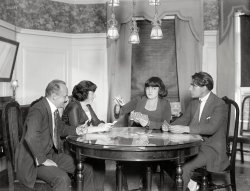
- Tales of Tarrytown: 1913
- ... Plant. This was in 1851 at 180 North Exeter Street in Baltimore. The Good Humor Man and Mr Softee showed up much later.
... Posted by Dave - 05/04/2014 - 11:27pm -
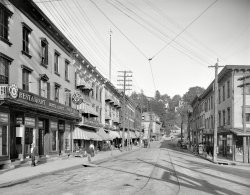
- Cuyahoga Lift Bridge: 1910
- ...
This is a Scherzer Rolling Lift Bridge known as Baltimore & Ohio Bridge No. 464, built in 1907, which I believe still ... Posted by Dave - 10/13/2018 - 10:36am -

- Bring It On: 1915
- ... Mrs. John Scudder, the mother; George W. Latimer, of Baltimore, Mr. Scudder; and Howard Treat, William Lloyd Garrison.
... Posted by Dave - 09/12/2011 - 10:19am -
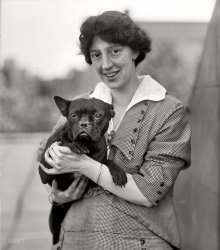
- Radio Highlights: 1957
- ... Bizet.”
Washington Redskins versus Chicago Bears and Baltimore Colts versus Los Angeles Rams
“Fact the Facts: Belated kudos to ... Posted by Dave - 06/02/2017 - 12:50pm -
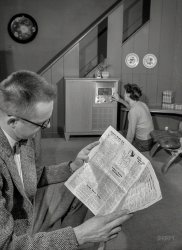
- Working Mother: 1943
- ...
Striking resemblance Marin Alsop, Conductor of The Baltimore Symphony Orchestra:
Make up or no make up... The women who ... Posted by Dave - 08/30/2012 - 4:48pm -
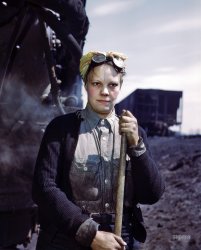
- Happy Overall: 1930s
- ... in the wintertime.
After too many winters of snow in Baltimore I and Snow made a deal.
Snow stays up in the mountains and I stay ... Posted by Tony W. - 09/17/2011 - 8:16pm -
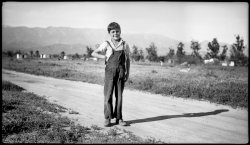
- Double Bill: 1926
- ... weeks. Her first training in this direction was gained in Baltimore girls' school and fortified the last two summer seasons here by her ... Posted by Dave - 12/03/2013 - 9:41am -
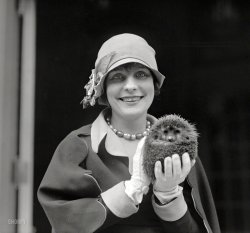
- Tub Tots: 1939
- ... sink plus it was also my kiddie pool during hot summers in Baltimore.
By the early 50's I could no longer sit in it but it still ... at Christmas time as the only festively lit tree in our Baltimore row house alley.
In the 80's I moved away and never saw it again ... Posted by Dave - 05/04/2018 - 5:28pm -

- Washington Noir: 1926
- ... sign. They had the Washington market. Hendler was out of Baltimore, and took up the "Velvet" name and much of the product ... Posted by Dave - 07/17/2012 - 10:14pm -
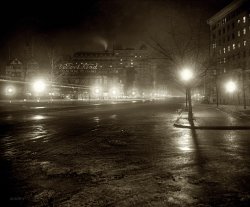
- Fair Warning: 1940
- ... was originally made (by Globe Brewing) in my hometown of Baltimore.
Globe was founded in the mid-1700s and Arrow has a long history ... Posted by Dave - 11/11/2018 - 6:18pm -
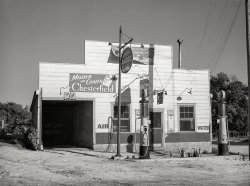
- 1920's Real Photo Postcard
- ... of Red Men is a fraternal organization established in the Baltimore, Maryland in 1834. Their rituals and regalia are modeled after those ... Posted by Viewliner - 11/23/2007 - 11:17pm -
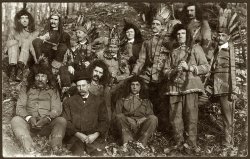
- Green Pastures: 1940
- ... cabins along U.S. Highway No. 1, between Washington and Baltimore. Near Waterloo, Maryland." Medium format negative by Jack Delano for ... Posted by Dave - 01/22/2019 - 11:47am -
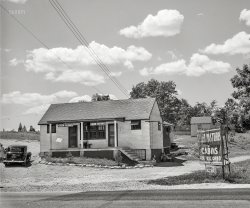
- Cheersh: 1941
- ... Bruce Crossing is in the UP, and Natty Boh was brewed in Baltimore. I would have thought Milwaukee or Detroit suds would have been the ... Posted by Dave - 02/29/2020 - 5:46pm -
![Cheersh: 1941 August 1941. "Farm boys in beer parlor on Sunday afternoon. Finnish community of Bruce Crossing, Michigan." Medium format acetate negative by John Vachon. View full size.
Bottle Can GlassTo me it always seemed that pouring from a bottle or can into a glass allowed the brew to breathe a little, thus taming the carbonation and improving taste. After the third one though, who cares.
Royal Bohemian BeerLooks like they are enjoying Royal Bohemian from the Duluth Brewing & Malting Company.
Sisu, eh?All communities thereabouts are Finnish communities. Pritnear every Yooper is at least part Finn.
GlassesFind out that they use glasses to drink beer. I'm not American and I find that in every American film people drink beer directly from bottles. Is it now normal as it was normal to use glasses in forties?
[In my experience, most bottle beer in restaurants and bars here in America is poured into glasses or mugs. - Dave]
Natty BohThe boys are enjoying some National Bohemian Pilsner. A bit surprising, since Bruce Crossing is in the UP, and Natty Boh was brewed in Baltimore. I would have thought Milwaukee or Detroit suds would have been the beer of choice.
[The beer is Minnesotan -- Royal Bohemian from Duluth. - Dave]
(The Gallery, Eateries & Bars, John Vachon)](https://www.shorpy.com/files/images/SHORPY-8c19965a.thumbnail.jpg)
- Harris & Ewing: 1924
- ... so far as is known. A leather case left at the store by a Baltimore man, however, had been moved from a place behind the safe to a ... the inquest yesterday, Dr. Berman's body was sent to Baltimore for burial.
America's Studio Beautiful
... Posted by Dave - 08/28/2012 - 12:09pm -
![Harris & Ewing: 1924 Washington, D.C., circa 1924. "Harris & Ewing. Exterior, new studio." The new offices of "America's studio beautiful" opened in November 1924 at the same F Street address as the previous building (whose ground-floor tenant, Lucio's jewelry store, was the scene of a robbery/arson/suicide-by-cyanide shortly before the building was remodeled). The basement storage vault was said to have held a million glass negatives, the bulk of which were donated to the Library of Congress in 1955. Harris & Ewing Collection glass negative. View full size.
True CrimeWashington Post, May 26, 1924.
OPTICIAN DIES WHEN HELD
AS HE LEAVES BURNING GEM SHOP
Police Say Berman Had No Right in Store;
Suspect Robbery Aim
EXPLOSION CALLS POLICE TO SCENE
Doctor Discerned Walking About in
Flames and Smoke; Had Office There.
Dr. Lewis Berman, 36 years old, an optician, fell dead when placed under arrest early yesterday, a moment after he escaped from an explosion and fire which wrecked Lucio's jewelry store at 1313 F street NW.
Policemen Davis and Helms, of the First precinct, were standing at Fourteenth and F streets, about five minutes after 3 when an explosion occurred and the plate glass window of the jewelry store was shattered.
When they reached the store they found its exterior filled with flame and smoke through which they saw a man running back and forth. Davis called upon him to come out, but he was seen falling to the floor and crawling under a showcase. The policeman then brandished his revolver and threatened to fire, hoping to frighten the man into coming out.
Firemen Smash in Door.
A few moments later firemen smashed in the door with axes, and Dr. Berman ran out. As Policeman Davis arrested him, Dr. Berman told the officer, "I had a right to be in there." He repeated this several times, it is said, and then collapsed. When taken to Emergency hospital, he was pronounced dead.
Dr. Berman until Wednesday, it is said, had offices in the rear of the jewelry store. On that day he had sold out his interest to Mrs. Margaret Perkinson, who conducted the jewelry business.
Earl Perkinson, husband of the proprietor, was in the store until about 10:30 o'clock Saturday night. He placed diamonds and the receipts for two days' business in the safe, locked the store and left it.
Dr. Berman, according to police, occasionally went into the store, through courtesy, and had left there about 7 o'clock. Later in the evening he registered at a Turkish bath, but did not occupy his room there, police say. The next event was the explosion.
Police declare in their belief that an attempt was made to rob the store and a fire started to "cover up" the robbery. A duplicate key was found in Berman's pockets. He had no right to the key, police say.
Wife Can't Believe It.
When Mrs. Berman was informed of her husband's death by Mrs. Perkinson, she cried out, "Oh, I can't believe it, I can't believe it."
At the hospital she said that her husband probably, in passing the store, had seen burglars there and had entered to rout them.
Mrs. Berman has a daughter seven years old. The Berman residence is at the Home apartments, Seventh and K streets northwest.
An inquest will be held at 1:30 o'clock this afternoon to determine the cause of Dr. Berman's death. His clothing had not been burned, and it is thought he died from inhaling smoke and flames.
Washington Post, May 27, 1924.
BERMAN A SUICIDE, JURY ASSERTS;
GEM STORE SET ON FIRE
Optician Took Large Dose of Cyanide
Of Potassium, Chemist Finds.
PACKAGE OF JEWELRY MOVED NEAR DOOR
Wife Holds He Entered Shop to Get
Eyeglasses Left There for Repair.
A large dose of cyanide of potassium, self administered, caused the death of Dr. Lewis Berman, 36-year-old optician, who expired Sunday morning a moment after he had dashed out of the flame and smoke that enveloped Lucio's jewelry store, 1313 F street northwest.
This was the verdict yesterday of a coroner's jury which brought out these additional declarations:
The fire in Lucio's store was as was of incendiary origin.
Dr. Berman, who until Wednesday had rented space in the store, had no right in the store at that time of the morning, nor had he been authorized to have the key found in a pocket of his clothes.
The coroner's jury based its verdict of suicide on the testimony of Dr. S.C. Moton, assistant District chemist, who told of having found evidence is in the dead man's stomach of a large quantity of cyanide poisoning.
Police last night advanced the theory that Dr. Berman swallowed the poison the moment after he saw Policeman Davis at the door. It was pointed out that cyanide is a quick acting poison, and in view of the quantity taken, Berman could not have taken it much sooner.
None of the jewelry or other stock in the store was touched, so far as is known. A leather case left at the store by a Baltimore man, however, had been moved from a place behind the safe to a counter near the door. When it was placed behind the safe it was unwrapped. When found after the fire it was inclosed in newspapers and tied with heavy twine. The case contained watches and other jewelry.
Mrs. Berman, widow of the optician, at the inquest said: "I believe he wanted to get a pair of glasses which had been left for repairs by Abe Friedenberg."
Mr. Friedenberg, who lives at 3517 Fourteenth street northwest, concurred in this belief. He said that he had asked Dr. Berman to turn the glasses over to him before Sunday so that he would have them to read the Sunday newspapers.
Following the inquest yesterday, Dr. Berman's body was sent to Baltimore for burial.
America's Studio Beautiful
+86Below is the identical view taken in April of 2010. However, the occupant now deals in food instead of film.
Used to work in the buildingI worked in the building for 3 years. The 2nd - 4th floor of both buildings are now office space. When the previous tenant moved into 1313 F in the later 90s, they found a bunch of old negatives that belonged to Harris & Ewing.
[And did what with them?? - Dave]
(The Gallery, D.C., Harris + Ewing, Stores & Markets)](https://www.shorpy.com/files/images/17203a.thumbnail.jpg)
- Dynamite Kills Two Babes: 1920
- ... in Montgomery County before executions were centralized to Baltimore.
The old house You can still see remnants of the exploded ... Posted by Dave - 06/11/2015 - 3:51pm -
